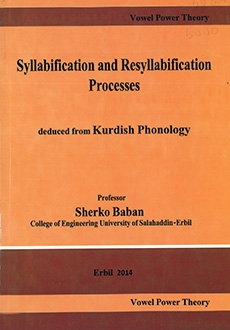|
SUMMARY
1. Syllabification Processes
In Vowel Power Theory, the vowel is, natively, a powerful syllabic phoneme (syllable-source), in phonetics because it is an inborn part from the mono-shape frame of a syllable, but in a defective state:
/V/= phoneme = hollow syllable = power source
Figure (0.1) illustrates the syllabic shape of a vowel phoneme,
containing the following cavities:
Head Empty CL /V/ TP Tail
Figure (0.1): The mono-shape of the vowels.
- The empty consonantal location CL is a defect in the syllabic frame because the vowel head is still active, and its defect is repaired, exclusively, by a future consonant, in order to spend its syllabic power, in forming a duplex sound crystal |C^V|. By virtue of this consonant C, the syllabic frame of the vowel gets its linguistic status:
/C/= Syllabify-able phoneme| by vowel power
- The empty tail pocket TP is not a defect in the syllabic frame because its charge is optional. By virtue of this pocket, the defective syllabic frame of the vowel could generate three defective syllables (QVo, QV c, QV cc).
In other words, each vowel is a (syllabic-phoneme), in two syllabic states:
(a). A defective syllabic state, when its head waits to be welded with a Ctail, in the consonantal location CL, as illustrated in figure (0.1).
(b) A perfect syllabic state, when the V-head is welded with a C-tail, in forming a duplex sound crystal, figure (0.2). This case is called normal syllabification, in three normal syllables (CVo, CVc, CVcc). Or, the syllabification power of the vowel is spent in a weld joint between a Vhead and a C-tail, for forming a duplex sound crystal. ICAVI, in the output. When a phonetic form is syllabified, it will be saved in the mind, and it will be used, freely, via the syllable control unit. For example the grammatical suffixes (-nessl eve, -lessl eve and -mentl cvcc) are not defective, and they do not need a re-syllabification process. Figure (0.3) illustrates the coinage of the suffix (-ment) in its perfect heavy syllable frame (CVcc).
…..
| 